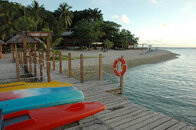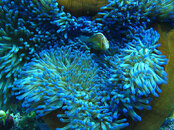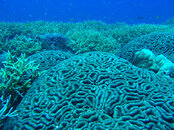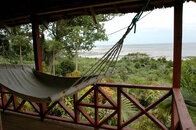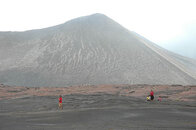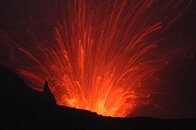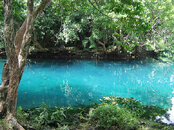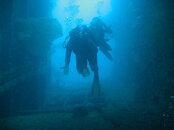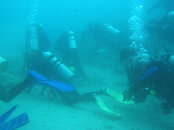I just returned from Vanuatu at the end of February, and here’s what I found…
January through March is the hot, rainy season, although it wasn’t as hot as I expected it to be (80-90F, 30C). Breezes kept things tolerable most of the time, only when it rained – and that was often, but not usually for very long – and the wind stopped did it get truly sultry. Most of the hotels and resorts were half empty or more, so if you’re looking for a good deal this may be the time of the year to go. English is spoken, or at least a pidgin version of it, so there’s no problem booking things on-the-fly or over the phone. Water temperatures were bath-water warm, 85F (29C) near shore, cooler at depth. Most people dove in 3mm full wetsuits or shorties, and some thicker-skinned divers went just in bathing suits. There’s a few stingers in the water, nothing to be worried about, but I occasionally swam into something invisible that later caused welts, and that was good enough reason for me to wear a wetsuit.
The water is drinkable in most areas. Malaria is endemic, prophylaxis is recommended. Plan ahead, as some malaria tablets may require you to start a week in advance. Consider bringing a mosquito net, even if you’re staying in a hotel or resort area. Roads are generally unpaved outside of the cities, and the veneer of civilization can be very thin. If you’re an armchair anthropologist, this is the place for you! Many people still live in simple grass huts, and some villagers only wear grass skirts or penis sheathes made of leaves. Pentecost island is the home of land diving (later to become bungy jumping, courtesy of A.J. Hackett), celebrating the yearly yam harvest – that occurs sometime later in the year, May or June, so I missed it. Tanna island has the John Frum cargo cultists. It’s all good fun and the Ni-Vanuatu (what people from Vanuatu are called) are happy to take you around and show off their islands and way of life. Everyone was friendly, especially when they found out I was an American… which was refreshing, for a change.
Apparently Americans are a bit of a novelty here. The capital city, Port Vila, is only a 2-3 hour flight directly from either Brisbane or Auckland, and Aussies in particular take advantage of the proximity. Most of the travelers I met were either Kiwis or Aussies, with a few Japanese and Europeans sprinkled in. Prices for food are high, with simple lunches being about $10US, a nice dinner around $15-20US, and local Tusker beer $4 at most restaurants. Mid-priced resorts are about $75-$100US a day for single occupancy, but remember that I was there during the low season. You could probably get better prices if you walked in off the street and asked for a deal. I visited three islands: the main one, Efate; remote Tanna; and Espiritu Santo. My 3-hour flight originated in Auckland, New Zealand. Flights are also available from Nadi, Fiji, and Honiara, Solomon Islands, so adventurous or deep-pocketed divers may be able to combine Vanuatu with other destinations. The trip was somewhat impromptu for me and I admit I wasn’t totally prepared (i.e., the only scuba gear I brought was my dive computer – big mistake, as you will see), but set out to explore the place and find some good diving…
Part 1: Hideaway Island Resort, near Port Vila
There aren’t a whole lot of reviews on the web about diving in Vanuatu, the best source turned out to be some Aussie bulletin boards (with a nod to almitywife’s reviews on ScubaBoard, which I must have read about a dozen times). The Aussies who reviewed Hideaway either love it or hate it, there doesn’t seem to be any middle ground. This was puzzling before I went but now I understand…
The resort is located on its own island, and a small boat takes guests back and forth to the nearby beach. It’s about a 15 drive from downtown Port Vila. The short story is that, for families who just want a quick, safe snorkeling vacation, this is probably a good bet. The resort is kid-friendly, the staff is cheerful and friendly, and there’s some okay snorkeling right off shore. The high point of every day was dinner – which was excellent. There are three classes of lodging: the dorm house, the “lodge” with individual rooms but shared bathroom, and separate bungalows. I stayed in the lodge.
The reason some reviewers pan the place is that there are a lot of maintenance issues that need attention. There’s work going on, but it all appears to be directed toward the construction of new bungalows. The individual bungalows are nice and would be the preferred place to stay. But the lodge rooms are in need of help (ripped screens, ants, etc). Especially appalling are the shared lodge bathrooms. I tolerated that for a few days until I found the dorm bunkhouse, which is rather nice for people on a tight budget – it was empty except for one backpacker while I was there – and has bathrooms that are simple but clean and functional. I kept the room in the lodge, but walked over to the dorm house to use the toilet or shower.
In a small defense of the resort, I had long conversations with a couple of the new co-owners about the state of things. Most of the talk was centered on the diving and rental equipment (more on that below), but I also mentioned the maintenance problems. They are making a sincere attempt to improve things. Most of the problems were simple stuff that would be easy to fix. Overall, the place has the potential to be a high-class establishment, and that appears to be their objective. But they have a long way to go.
The rental scuba gear was in inexcusably bad condition. I could go through a list of all the problems I experienced – cracked hoses, torn mouthpieces, corroded sinter filters, leaking tank valves, etc – but the bottom line is that, in its current state, their gear is dangerous and should not be used. When I pointed out a problem they were responsive and happily corrected it, but I shouldn’t have to do that. They say new stuff is “on order”, but until you start hearing more positive reports serious divers should bring their own gear.
There’s a lot of diving around Port Vila, some of it very good. It’s pretty diving, with simple reefs and lots of tropical fish. There are several shipwrecks in the area as well, at least one purposely sank as a reef. The reefs are mostly hard corals, and much of it is alive and healthy. There was very little current or surge, visibility averaging about 60ft (20m) on most of my dives, and only a little surface chop from the afternoon breezes. The dive sites are about 5 to 20 minutes away by slow boat, and Hideaway Resort goes out three times a day, weather permitting, regardless of the number of divers. On many dives I was the only guest on the boat.
The reef off of Hideaway Island is supposedly the only protected reef in Vanuatu, although it sounds like the protection has no teeth and is largely just a cooperative agreement between the resorts, the local villagers, and the government. I didn’t see much in the way of bigger sea life, at least nothing bigger than about 24 inches (60cm). No lobsters, no crabs, and only one small eel. It was almost as if the reef had been picked clean of anything edible. There are more dive sites around Port Vila and the island of Efate that I didn’t get to, so it may be different elsewhere. YMMV. Still, if you’re looking for easy, warm water diving, this is a good area.
...Review continued below...
January through March is the hot, rainy season, although it wasn’t as hot as I expected it to be (80-90F, 30C). Breezes kept things tolerable most of the time, only when it rained – and that was often, but not usually for very long – and the wind stopped did it get truly sultry. Most of the hotels and resorts were half empty or more, so if you’re looking for a good deal this may be the time of the year to go. English is spoken, or at least a pidgin version of it, so there’s no problem booking things on-the-fly or over the phone. Water temperatures were bath-water warm, 85F (29C) near shore, cooler at depth. Most people dove in 3mm full wetsuits or shorties, and some thicker-skinned divers went just in bathing suits. There’s a few stingers in the water, nothing to be worried about, but I occasionally swam into something invisible that later caused welts, and that was good enough reason for me to wear a wetsuit.
The water is drinkable in most areas. Malaria is endemic, prophylaxis is recommended. Plan ahead, as some malaria tablets may require you to start a week in advance. Consider bringing a mosquito net, even if you’re staying in a hotel or resort area. Roads are generally unpaved outside of the cities, and the veneer of civilization can be very thin. If you’re an armchair anthropologist, this is the place for you! Many people still live in simple grass huts, and some villagers only wear grass skirts or penis sheathes made of leaves. Pentecost island is the home of land diving (later to become bungy jumping, courtesy of A.J. Hackett), celebrating the yearly yam harvest – that occurs sometime later in the year, May or June, so I missed it. Tanna island has the John Frum cargo cultists. It’s all good fun and the Ni-Vanuatu (what people from Vanuatu are called) are happy to take you around and show off their islands and way of life. Everyone was friendly, especially when they found out I was an American… which was refreshing, for a change.
Apparently Americans are a bit of a novelty here. The capital city, Port Vila, is only a 2-3 hour flight directly from either Brisbane or Auckland, and Aussies in particular take advantage of the proximity. Most of the travelers I met were either Kiwis or Aussies, with a few Japanese and Europeans sprinkled in. Prices for food are high, with simple lunches being about $10US, a nice dinner around $15-20US, and local Tusker beer $4 at most restaurants. Mid-priced resorts are about $75-$100US a day for single occupancy, but remember that I was there during the low season. You could probably get better prices if you walked in off the street and asked for a deal. I visited three islands: the main one, Efate; remote Tanna; and Espiritu Santo. My 3-hour flight originated in Auckland, New Zealand. Flights are also available from Nadi, Fiji, and Honiara, Solomon Islands, so adventurous or deep-pocketed divers may be able to combine Vanuatu with other destinations. The trip was somewhat impromptu for me and I admit I wasn’t totally prepared (i.e., the only scuba gear I brought was my dive computer – big mistake, as you will see), but set out to explore the place and find some good diving…
Part 1: Hideaway Island Resort, near Port Vila
There aren’t a whole lot of reviews on the web about diving in Vanuatu, the best source turned out to be some Aussie bulletin boards (with a nod to almitywife’s reviews on ScubaBoard, which I must have read about a dozen times). The Aussies who reviewed Hideaway either love it or hate it, there doesn’t seem to be any middle ground. This was puzzling before I went but now I understand…
The resort is located on its own island, and a small boat takes guests back and forth to the nearby beach. It’s about a 15 drive from downtown Port Vila. The short story is that, for families who just want a quick, safe snorkeling vacation, this is probably a good bet. The resort is kid-friendly, the staff is cheerful and friendly, and there’s some okay snorkeling right off shore. The high point of every day was dinner – which was excellent. There are three classes of lodging: the dorm house, the “lodge” with individual rooms but shared bathroom, and separate bungalows. I stayed in the lodge.
The reason some reviewers pan the place is that there are a lot of maintenance issues that need attention. There’s work going on, but it all appears to be directed toward the construction of new bungalows. The individual bungalows are nice and would be the preferred place to stay. But the lodge rooms are in need of help (ripped screens, ants, etc). Especially appalling are the shared lodge bathrooms. I tolerated that for a few days until I found the dorm bunkhouse, which is rather nice for people on a tight budget – it was empty except for one backpacker while I was there – and has bathrooms that are simple but clean and functional. I kept the room in the lodge, but walked over to the dorm house to use the toilet or shower.
In a small defense of the resort, I had long conversations with a couple of the new co-owners about the state of things. Most of the talk was centered on the diving and rental equipment (more on that below), but I also mentioned the maintenance problems. They are making a sincere attempt to improve things. Most of the problems were simple stuff that would be easy to fix. Overall, the place has the potential to be a high-class establishment, and that appears to be their objective. But they have a long way to go.
The rental scuba gear was in inexcusably bad condition. I could go through a list of all the problems I experienced – cracked hoses, torn mouthpieces, corroded sinter filters, leaking tank valves, etc – but the bottom line is that, in its current state, their gear is dangerous and should not be used. When I pointed out a problem they were responsive and happily corrected it, but I shouldn’t have to do that. They say new stuff is “on order”, but until you start hearing more positive reports serious divers should bring their own gear.
There’s a lot of diving around Port Vila, some of it very good. It’s pretty diving, with simple reefs and lots of tropical fish. There are several shipwrecks in the area as well, at least one purposely sank as a reef. The reefs are mostly hard corals, and much of it is alive and healthy. There was very little current or surge, visibility averaging about 60ft (20m) on most of my dives, and only a little surface chop from the afternoon breezes. The dive sites are about 5 to 20 minutes away by slow boat, and Hideaway Resort goes out three times a day, weather permitting, regardless of the number of divers. On many dives I was the only guest on the boat.
The reef off of Hideaway Island is supposedly the only protected reef in Vanuatu, although it sounds like the protection has no teeth and is largely just a cooperative agreement between the resorts, the local villagers, and the government. I didn’t see much in the way of bigger sea life, at least nothing bigger than about 24 inches (60cm). No lobsters, no crabs, and only one small eel. It was almost as if the reef had been picked clean of anything edible. There are more dive sites around Port Vila and the island of Efate that I didn’t get to, so it may be different elsewhere. YMMV. Still, if you’re looking for easy, warm water diving, this is a good area.
...Review continued below...



